Page 268 of 402
4. Remove any rust or dirt
-1 from the wheel bolts,
mounting surfaces and
spare wheel.
A CAUTION:
Rust or dirt on the wheel, or on the parts to
which
it is fastened, can make the wheel nuts
become loose after a time. The wheel could come
off and cause an accident. When you change a
wheel, remove any rust or dirt from the places
where the wheel attaches to the vehicle. In an
emergency, you can use a cloth or
a paper towel
to do this; but be sure to use a scraper or wire
brush later, if you need to, to get all the rust or
dirt off.
.h CAUTION:
Never use oil or grease on studs or nuts. If you
do, the nuts might come loose. Your wheel
could
fall off, causing a serious accident.
5. Replace the wheel nuts
with the rounded end of
the nuts toward the
I wheel. Tighten each nut
by hand until the wheel
is held against the hub.
5-33
Page 274 of 402
Rocking Your Vehicle To Get It Out
clear the area around your front wheels. Then shift back
NOTICE:
I First, turn your steering wheel left and right. That will
Spinning your wheels can destroy parts of your
shift lever is in FIRST (1) or SECOND (2) gear. Release forth, you can destroy your transaxle.
The enhanced traction system will turn off when the too fast while shifting your transaxle back and
SECOND (2), spinning the wheels as little as possible. vehicle as well as the tires. If you spin the wheels
and forth between REVERSE (R) and FIRST (1) or
the accelerator pedal while you shift, and press lightly
on the accelerator pedal when the transaxle
is in gear. If
For information about using tire chains on your vehicle, that doesn’t get you out after a few tries, you may need
see
“Tire Chains” in the Index. to be towed out. If you do need to be towed out, see
“Towing Your Vehicle” in the Index.
Page 289 of 402
I
1
I
3 Checking Engine Oil
3800 or 3800 Supercharged Engine
Turn off the engine and give the oil a few minutes to
drain back into the oil pan.
If you don’t, the oil dipstick
might
not show the actual level. Pull out the dipstick
and clean
it with a paper towel or
cloth, then push it back in all the way. Remove it again,
keeping the tip
down, and check the level.
3100 Engine
6-14
Page 297 of 402

Automatic Transaxle Fluid
When to Check and Change
A good time to check your automatic transaxle fluid
level is when the engine oil is changed.
Change both the fluid and filter every
50,000 miles
(83 000 km) if the vehicle is mainly driven under one or
more of these conditions:
0 In heavy city traffic where the outside temperature
In hilly or mountainous terrain.
regularly reaches
90” F (32 O C) or higher.
0 When doing frequent trailer towing.
0 Uses such as found in taxi, police or delivery service.
If you do not use
your vehicle under any of these
conditions, the fluid and filter
do not require changing.
See “Scheduled Maintenance Services” in the Index.
How to Check
Because this operation can be a little difficult, you may
choose to have
this done at your Pontiac dealership
Service Department.
If you do
it yourself, be sure to follow all the
instructions here, or you could get a false reading on
the dipstick.
NOTICE:
Too much or too little fluid can damage your
transaxle.
Too much can mean that some of the
fluid could come out and fall on
hot engine parts
or exhaust system parts, starting a fire. Be sure to get an accurate reading if you check your
transaxle fluid.
6-22
Page 299 of 402
Then, without shutting off the engine, follow
these steps:
3100 Engine 3800 or 3800 Supercharged Engine
1. The transaxle fluid dipstick handle is the red loop
near the back of the engine. Pull out the dipstick and
wipe
it with a clean rag or paper towel.
6-24
Page 305 of 402
Radiator Pressure Cap
NOTICE:
Your radiator cap is a 15 psi (105 kPa)
pressure-type cap and must be tightly installed to prevent coolant loss and possible engine
damage from overheating. Be sure the arrows
on the cap line
up with the overflow tube on
the radiator filler neck.
When you replace your radiator pressure cap, a GM cap
is recommended.
Thermostat
Engine coolant temperature is controlled by a thermostat
in the engine coolant system. The thermostat stops the
flow of coolant through the radiator until the coolant
reaches a preset temperature.
When
you replace your thermostat, a GM thermostat
is recommended.
Power Steering Fluid
The power steering
fluid reservoir
is toward
3100 Engine
6-30
Page 322 of 402

After the tires have been rotated, adjust the front and rear inflation pressures as shown on
the Tire-Loading
Information label. Make certain that all wheel nuts are properly tightened. See “Wheel
Nut Torque” in
the Index.
L
Rust or dirt on a wheel, or on the parts to which
it is fastened, can make wheel nuts become loose
after a time. The wheel could come
off and cause
an accident. When you change a wheel, remove
any rust or
dirt from places where the wheel
attaches to the vehicle. In an emergency, you can
use a cloth or a paper towel to do this; but be
sure to use
a scraper or wire brush later, if you
need to, to get all the rust or dirt
off. (See
“Changing
a Flat Tire” in the Index.)
I I
When It’s Time for New Tires
.. I
One way to tell when it’s
time for
new tires is to
check the treadwear
indicators, which will appear when your tires have
only 1/16 inch (1.6 mm) or
less
of tread remaining.
YOU need a new tire if any of the following statements
are true:
0
0
0
0
0
You can see the indicators at three or more places
around the tire.
You can see cord or fabric showing through the
tire’s rubber.
The tread or sidewall is cracked, cut or snagged deep
enough to show cord or fabric.
The tire has a bump, bulge or split.
The tire has a puncture, cut or other damage that can’t be repaired well
because of the size or location
of the damage.
6-47
Page 328 of 402

Don’t use any of these unless this manual says you can.
In many uses, these will damage your vehicle:
Alcohol
Laundry Soap
0 Bleach
Reducing Agents
Cleaning the Inside of Your Vehicle
Use a vacuum cleaner often to get rid of dust and loose
dirt. Wipe vinyl, leather, plastic and painted surfaces
with a clean, damp cloth.
Your dealer has two cleaners, Multi-Purpose Interior Cleaner
and Capture Non-Solvent
Dry Spot and Soil Remover for
cleaning
fabric and carpet. They will clean normal spots and
stains very well. You can get GM-approved cleaning
products from your dealer.
(See “Appearance Care and
Materials” in the Index.)
Here are some cleaning tips:
Always read the instructions on the cleaner label.
Clean up stains as soon as you can -- before they set.
0 Carefully scrape off any excess stain.
0 Use a clean cloth or sponge, and change to a clean area
If a ring forms after spot cleaning, clean the entire
often. A soft brush may be used
if stains are stubborn.
area immediately or it will set.
Using Multi-Purpose Interior Cleaner
on Fabric
1.
2.
3.
4.
5.
6.
7.
Vacuum and brush the area to remove any loose dirt.
Always clean a whole trim panel or section. Mask
surrounding trim along stitch
or welt lines.
Mix powdered cleaner following
the directions on
the container label to form thick suds.
Use suds only and apply with
a clean sponge. Don’t
saturate the material and don’t rub
it roughly.
As soon
as you’ve cleaned the section, use a sponge
to remove
the suds.
Wipe cleaned area with a clean, damp towel or
cloth.
Wipe with a clean cloth and let dry.
Special Fabric Cleaning Problems
Stains caused by such things as catsup, coffee (black),
egg, fruit, fruit juice, milk, soft
drinks, vomit, urine and
blood can be removed
as follows:
1. Carefully scrape off excess stain, then sponge the
soiled area with cool water.
2. If a stain remains, follow the multi-purpose interior
cleaner instructions described earlier.
6-53